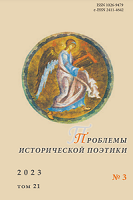Семантика и поэтика заглавия очерка И. А. Гончарова «Превратность судьбы»
Semantics and Poetics of the Title of I. A. Goncharov’s Essay “The Vicissitude of Fate”
Author(s): Gulzada G. BagautdinovaSubject(s): Semantics, Pragmatics, Russian Literature, 19th Century
Published by: Петрозаводский государственный университет
Keywords: I. A. Goncharov; title; historical and literary context; structure; semantics; pragmatics; genre; dramatic vicissitudes; The Tale of Woe and Woe; the motife of fate; God’s Providence; autocitation;
Summary/Abstract: For the first time, the article analyzes the structural, semantic, pragmatic aspects of the poetics of the title “The Vicissitude of Fate” by I. A. Goncharov. The title is an explicitly integral part of the framework text. In addition, the expression “vicissitude of fate” is structured and implicit, since it is included in the main content of the work. The phrase “vicissitude of fate” is endowed with stable semantic features, which were reflected in the works of other 19th-century writers: I. I. Lazhechnikov, N. V. Gogol, A. N. Ostrovsky, M. E. Saltykov-Shchedrin, V. M. Garshin, D. N. Mamina-Sibiryak, A. P. Chekhov. The plot twists and turns that determine the development of the plot of I. A. Goncharov’s work are com- parable to dramaturgical literature. However, Leonty Khabarov’s destiny is de- termined not by the ancient Greek fate, but by God’s providence. The motif of fate, which is the leitmotif of I. A. Goncharov’s “Vicissitude of Fate,” allows us to interpret the image of Leonty Khabarov in comparison with the Young Man from the Old Russian “Tale of Woe-Wickedness.” Unlike the Young Man from The Tale of Woe and Wickedness, who can and must find salvation for his soul only outside the walls of the monastery, Leonty Khabarov finds blissful salvation in worldly life thanks to the miraculous intervention of the Mother of God, to whom he prayed in the Kazan Cathedral of St. Petersburg. The final plot twists and turns that led Leonty Khabarov from misfortune to a happy, thriving, prosperous life are due to the Miracle motif. Khabarov’s first name is Leonty, and the motif of fate creates an association between the “small” epic prose of I. A. Goncharov — “The Vicissitude of Fate” — and the novel “The Cliff.” The writer uses the artistic technique of autocitation, which is found in many of his works.
Journal: Проблемы исторической поэтики
- Issue Year: 21/2023
- Issue No: 3
- Page Range: 80-96
- Page Count: 17
- Language: Russian

